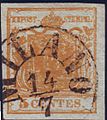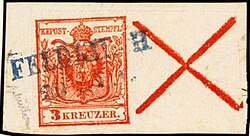Coat of arms edition 1850
On June 1, 1850, the first postage stamps in the Austrian Empire including the countries of the Hungarian Crown , the Kingdom of Lombardy-Venetia and Liechtenstein , which had a postal contract with Austria until 1921, became valid with the issue of the coat of arms .
General
Five stamps were issued for one, two, three, six and nine kreuzers , with the holdings of a value of twelve kreuzers instead of the value of nine kreuzers being almost completely destroyed shortly before June 1, 1850. The first Austrian stamp issue showed the Austrian coat of arms and was originally intended as a temporary solution. The next edition was not due to follow until 1858.
For the local postage stamps for two cruisers had to be used. Depending on the distance and lot (in Austria mostly 17.5 grams ), other tariffs were used. The first postage rate up to and including ten miles (around 75.86 km) was set with three cruisers, up to 20 miles were stamps for six cruisers and over 20 miles were stamps for nine cruisers. For letters of one to two lots you have to pay double the postage and for two to three lots you have to pay three times the postage. Printed matter could be posted more cheaply and a surcharge was charged for commendation items .
Value of six cruisers with cancellation from S. Pölten ( Sankt Pölten )
Value to nine Kreuzers with cancellation from Vienna
Due to the currency change and the adoption of the convention coin (1 guilder to 100 kreuzers instead of the previous 60 kreuzers) on November 1, 1858, new stamps were issued with the emperor's head issue in 1858 . The stamps of the first issue could be used up with the new value by December 31, 1858.
Edition for Lombardy and Veneto
Separate definitive issues were printed for the regions of Lombardy (until 1858) and Veneto (until 1866), which originally belonged to Austria , because the areas belonging to the Austrian Empire but not to the German Confederation are silver currency and not, like the rest of Austria, the poorer paper currency had.
The stamps visually corresponded to the Austrian issues, but differed in the currency denomination centesimi and lira .
Design and execution
The coat of arms edition was first printed in 1850 on hand-made, rough and uneven-looking paper, with sheet watermarks and in 1854 also on machine-made, smooth paper without watermarks. It was imperforated, but attempts at perforation had already been made.
Andrew's crosses
St. Andrew's crosses were also used on the stamp sheets . At that time, a print sheet comprised four switch sheets , each with eight rows and columns. So this resulted in 64 stamps per sheet. At that time, however, it was particularly important that buying several sheets (e.g. from companies) did not result in inconvenient amounts. That is why the idea came up to leave the last four fields of a sheet free. When buying seven six-kreuzer bows, for example, you only had to pay 42 guilders and not 44 guilders and 48 kreuzers.
Leaving the last four fields blank, however, resulted in a new problem that was solved with the introduction of St. Andrew's crosses. The empty fields could have been ideally used by counterfeiters to produce forged postage stamps. Therefore, it was decided to make them unusable by printing St. Andrew's crosses on them. The St. Andrew's crosses have the respective color of the stamp and come in two different types. The crosses are always in the last line of the sheet and can be placed either in the middle or on the left or right edge. With the introduction of the new currency system in 1858 (100 kreuzers = 1 gulden), St. Andrew's crosses were no longer needed and were abolished.
Type differences
The Austrian Postal Administration intended to use these stamps only for a short time. Since the stamps were then in use for a long time, defects in the brand image were soon noticed, especially in the coat of arms and the indication of value, and improvements were made to the production tools, from which three main types can be identified today. Experts also distinguish additional subspecies, watermark positions and plate defects for each individual value . Although there are only five values in this edition, the variety of types is very large and maximum prices are paid for rare items.
Fakes
In these editions there were the so-called Veronese and Milanese forgeries to the detriment of the post office, which are very rare, popular and therefore valuable today.
Market value
In principle, this first Austrian edition is very popular with philatelists , as there are many differences in printing, color and paper.
A complete, unused Austrian set (1 to 9 Kreuzer) of this edition in the cheapest versions can be obtained privately for around 2,000 euros via online auctions. In the stamped version, around 100 euros are paid. Rarer types or colors are traded much higher. The unused and largely destroyed value of 12 Kreuzers is not to be had for less than 10,000 euros.
The coat of arms for Lombardy and Veneto (5 to 45 Centesimi) in the cheapest variants is available unused for around 4,000 euros privately via online auctions, canceled for around 100 euros.
There are reprints of the copies that can be recognized by their stronger colors and are sometimes cheaper.
List of expenses
The indication of the number of editions includes both the Austrian edition and the local editions of Lombardy and Veneto.
| values | colour | Issue date | Edition number | ANK number | Michel number |
|---|---|---|---|---|---|
| 1 | yellow | June 1, 1850 | 14,760,000 | 1 | 1 |
| 2 | black | June 1, 1850 | 13,420,000 | 2 | 2 |
| 3 | red | June 1, 1850 | 107,420,000 | 3 | 3 |
| 6th | brown | June 1, 1850 | 70,950,000 | 4th | 4th |
| 9 | blue | June 1, 1850 | 70,720,000 | 5 | 5 |
| 12 | blue | not spent | :: | I. | I. |
literature
- Ulrich Ferchenbauer : Austria 1850 to 1918 - special catalog and manual . 4th edition, Vienna 1981
- Michel Austria Special Catalog : 2003
- Austria Netto Catalog Austria standard catalog : 2010









